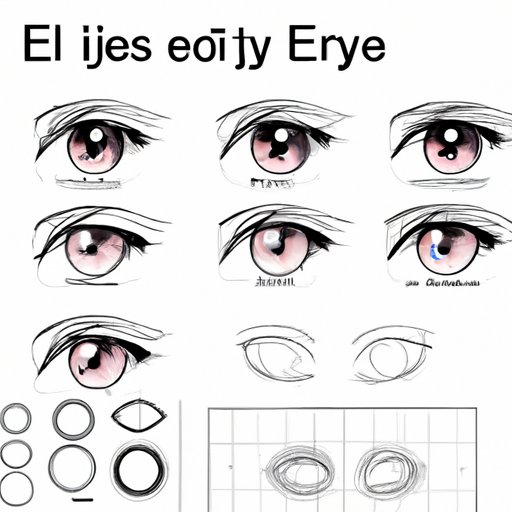
Introduction
Many people enjoy anime and manga as a form of entertainment, and often admire the artwork that accompanies it. One of the most important features that make anime so visually appealing is how the eyes are drawn. Anime eyes are known for their unique shapes, sizes, and styles, and mastering the art of drawing them is essential for any aspiring artist. This article aims to provide a comprehensive guide on how to draw anime eyes, from the basics to variations and supplies, and offer tips for troubleshooting common problems.
The Basics of Anime Eye Drawing: A Step-by-Step Tutorial
Before diving into the more complex aspects of drawing anime eyes, it’s important to understand the basics. Anime eyes are often larger and more expressive than realistic eyes, and their shape and style vary depending on the character and emotion being conveyed. Below is a step-by-step tutorial for drawing a basic anime eye:
- Start by drawing a circle for the iris and a smaller circle for the pupil, off-center from each other.
- Add a curved line above the iris for the upper eyelid, and a shorter, more curved line under the iris for the lower eyelid.
- Connect the upper and lower eyelids at the ends to create the shape of the eye.
- Add a curved line above the upper eyelid for the eyebrow.
- Draw a smaller circle or oval above the iris for the highlight.
- Add eyelashes and any other details or accessories.
Remember that anime eyes often have exaggerated proportions, so don’t be afraid to make them larger or more expressive. Eyelashes and eyebrows can also add character to the eye, so experiment with different styles and shapes.
Top Tips for Drawing Realistic Anime Eyes
While anime eyes are often stylized and exaggerated, adding a realistic touch can make a character come to life. Shading and highlighting techniques, as well as creating depth and reflections, can help achieve this goal. Below are some tips for improving the realism in anime eyes:
- Use multiple shades of pencil or marker to create a gradient or shading effect, with the darker shade towards the outer edges of the eye.
- Highlight the pupil and reflection using white pencil or marker to create a shiny effect.
- Add shadows under the upper eyelid and along the bottom edge of the iris to create depth and dimension.
- Experiment with different angles and lighting to create a more realistic look, such as adding shadows from the eyelashes.
Keep in mind the importance of practice in improving eye drawing skills, especially when it comes to shading and highlighting. Don’t be afraid to try different techniques and styles to find what works best for you.
Mastering the Art of Anime Eye Variations
As mentioned before, anime eyes come in many different styles and shapes, depending on the character and emotion being conveyed. From the classic “big eyes” to more intricate designs, creating variations in anime eyes can add interest and personality to a character. Below are some tips for creating different eye styles:
- Experiment with different proportions and angles, such as making the pupils larger or changing the slope of the eyelids.
- Try different iris designs, such as adding more detail or creating a starburst effect.
- Add different accessories to the eyes, such as large eyelashes or colored contacts.
- Pay attention to the shape and size of the eye in relation to the character’s other facial features, such as the nose and mouth.
Remember that anime eyes don’t have to be perfect or conform to a certain style. Creating unique variations can add personality and interest to your characters and make your artwork stand out.
Tools of the Trade: The Best Supplies for Drawing Anime Eyes
While anime eyes can be drawn using a variety of materials and supplies, certain tools can make the process easier and more efficient. Here are some supplies to consider when drawing anime eyes:
- Pencils of varying hardness, such as 2H, HB, and 2B, for shading and outlining the eyes.
- Colored pencils or markers for creating more detailed or colorful eyes.
- Erasers of different types, such as kneaded and electric, for correcting mistakes and smudging.
- Rulers or stencils to help with creating precise shapes and proportions.
- Specialized supplies like brush pens or watercolors can create unique effects in anime eyes.
Choosing and experimenting with different supplies can help you find what works best for your style and preferences. Don’t be afraid to try new materials and techniques to improve your eye drawing skills.
Troubleshooting Common Anime Eye Drawing Problems
Even with practice and the right tools, anime eye drawing can come with its own set of challenges. Common problems include uneven eyes, drawing the wrong shape or size, or struggles with shading and highlighting. Here are some tips for troubleshooting these problems:
- Use a reference image or photo to ensure proper proportions and angles.
- Draw both eyes separately to avoid mistakes in symmetry.
- Experiment with shading and highlighting techniques to find what works best for you.
- Practice regularly and don’t be afraid to start over or make mistakes.
Remember that improving your anime eye drawing skills takes practice and patience. Don’t get discouraged by mistakes or setbacks, and continue to strive for improvement.
Conclusion
Drawing anime eyes can be a challenging but rewarding skill to master. From the basics of shape and proportion to shading and highlighting techniques and variations in style, this article has provided a comprehensive guide on how to draw anime eyes. Experimenting with different tools and materials and troubleshooting common problems can help improve your skills and advance your artwork. Remember that practice makes perfect, and don’t be afraid to try new techniques and styles.





